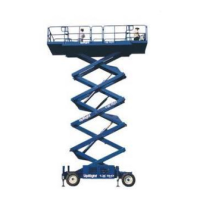Section
4-14 LX 31/41 Work Platform
Maintenance
Seal Replacement, Rear Motor
(Figure 4-16)
1. Remove all shaft related components from shaft (27)
(i.e. Keys, wire rings, nuts). To aid in reassembly of
the motor, make a v shaped set of lines from the
end cover (24) to the housing using either paint or a
marker. With shaft facing down, secure motor in
vise by clamping on to housing (15).
2. Loosen and remove seven bolts (26) holding motor
assembly together. Remove end cover (24) and
body seal (10). Discard seal. Remove balance plate
(22) taking care not to drop the four steel balls (23)
located in the four holes in the balance plate (22).
Remove rotor assembly (21), manifold boot (19),
manifold (18), drive link spacer (20) (note: some
motors do not use spacer), drive link (17) and thrust
bearing (13). Remove body seals (9) from rotor
assembly (21) and housing seal (8) from housing (15)
and discard seals. (note: compare old housing seal
(8) to the two housing seals included in kit to deter-
mine which one to use.)
3. Gently tap shaft (27) upward from housing (15) and
remove through rear of housing and lay aside.
Remove housing (15) from vise and turn over. Pry
dust seal (1) from housing. Push the seal carrier
(11), thrust washer (12) and thrust bearing (13)
down until they make contact with the roller bearing
(14) located in the housing bore.
4. Remove wire ring (2), steel backup shim (3) and high
pressure seal (4) from inner bore groove with a small
screwdriver (note: compare old high pressure seal
(8) to the two high pressure seals included in kit to
determine which one to use.). Lift out seal carrier
(11), thrust washer (12) and thrust bearing (13) from
the housing bore. Using a small screwdriver, care-
fully pry shaft seal (7), teflon backup seal (6) and
metal backup shim (5) from seal carrier (11) and
discard. Lay seal carrier (11), thrust washer (12) and
thrust bearing (13) aside. (note: if a new thrust
washer (12) and seal carrier (11) is included in kit,
old items may be discarded).
5. At this point, all parts should be cleaned in an oil-
based solvent and dried using compressed air (for
safety, observe all OSHA safety guidelines). All new
seals should be lightly coated in clean oil prior to
installation.
6. Place shaft (27) on a clean flat surface with output
end facing up. Place thrust bearing (13) then thrust
washer (12) on shaft. Lightly coat seal area of shaft
with clean oil and place plastic installation sleeve
with shaft seal (7) down onto shaft covering all
splines, keyways and wire ring grooves. Slide shaft
seal (7) down onto shaft (27) making sure that lip on
seal faces down (see figure 1 for correct seal orienta-
tion) until it contacts thrust washer (12). Remove
plastic installation sleeve. Carefully install the teflon
backup seal (6) onto the shaft (27) with the flat side
up and the seal lip facing the shaft seal (7). Place
the metal backup shim (5) onto the shaft and against
the teflon backup seal (6). Place the seal carrier (11)
onto the shaft (large end down) and carefully press
the seal carrier (11) down onto the seal assembly
using an arbor press and sleeve to compress the
seals into the carrier.
7. With pilot side facing up, place housing (15) on
spacers to raise housing approximately .250 above
work surface (note: spacers should allow shaft to
contact work surface). Place shaft/seal carrier
assembly into housing (15). Install high pressure seal
(4) into groove in housing. Install metal backup shim
(3) against high pressure seal (4) in groove in housing
bore by squeezing the shim (3) between thumb and
forefinger to bow shim. While maintaining bow in
shim, start the shim into the groove and use a small
screwdriver to push the shim into groove. Install
wire ring (2) into the groove making sure that the
ends are butted.
8. While holding shaft into housing, place housing/shaft
assembly in vise with shaft end down. Making sure
that end of drive link (17) with crowned splines goes
into shaft end, install drive link (17) into shaft and
tap lightly to seat the seal carrier assembly against
the wire ring (2). Place thrust bearing (13) over
drive link (17). If seal carrier (27) is properly seated
against wire ring (2), thrust bearing (13) will be flush
with rear surface of housing.
9. Install housing seal (8) into groove in housing (15).
Place manifold (18) onto housing (15) with side with
only seven holes facing housing (15). Install manifold
boot (19) over manifold (18) and align bolt holes.
Place body seals (9) in grooves in both sides of rotor
(21). Place rotor (21) onto manifold (18) with side of
rotor with chamfer in splines facing manifold (18).
10. Install balance plate (22) onto rotor (21) making sure
side with holes for steel balls (23) faces up. Install
four steel balls (23) in holes in balance plate (22).
Install end cover seal (10) into groove in end cover
(24) and place end cover onto balance plate (22).
Install seven assembly bolts (26) and pre-torque to
10 ft.lbs. Using the bolt torque sequence shown in
figure 2, final torque all bolts to 50 ft.lbs.
11. Remove motor from vise and place on work surface
with shaft (27) facing up. Making sure that lip on
seal (1) faces up, place dust seal (1) over shaft (27).
Using a sleeve and a hammer, carefully drive dust
seal (1) into place.
4.9

